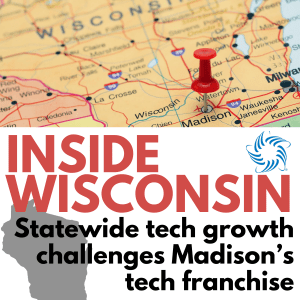By Tom Still
 MADISON, Wis. – For the better part of three decades starting in the 1980s, Madison was the only game in the state when it came to starting and growing tech-based businesses.
MADISON, Wis. – For the better part of three decades starting in the 1980s, Madison was the only game in the state when it came to starting and growing tech-based businesses.
That’s no longer the case, for a variety of reasons that are good for Wisconsin’s overall economy and potentially challenging to its capital city.
Examples of success in Wisconsin’s non-Madison tech economy are growing.
- In 2019, three of the five largest venture capital investments in the state involved two Rock County companies (SHINE Medical Technologies and NorthStar Medical Radioisotopes) and one with roots in Superior (Fasetto). Collectively, those three companies represented half of the $454 million in angel and venture capital raised by Wisconsin firms during that calendar year.
- An initial public offering by Jamf, which started in Eau Claire and now boasts offices around the world, was well-received when it hit the NASDAQ exchange in late July. The company has long offered management of Apple-based business and education software, and that’s even more in demand as organizations accelerate their digital transformations.
- TitletownTech in Green Bay has built momentum in a little more than a year since its formal launch as a venture studio and investment fund. Formed as a partnership between the Green Bay Packers and Microsoft, the fund attracted investment dollars from 14 other established companies with a stake in seeing a more vibrant economy in northeast Wisconsin. It has since invested in companies such as ChemDirect, which moved from California; Quantum Radius, which moved from Colorado; agriculture-related firms such as Seedlinked and Fork Farms; and others in healthcare and eCommerce.
- Kenosha County is an example of proximity and expertise, especially in advanced manufacturing, logistics and distribution, combining to spur development. Over the past 10 years or so before the COVID-19 pandemic, the Kenosha area had added 11,000 jobs, $2.1 billion in capital investment and 17.5 million square feet of industrial space. Its location north of Chicago and south of Milwaukee has helped. Nearby Racine County is home to a Foxconn plant, which may grow in significance now that Foxconn’s chief executive officer declared Aug. 12 that China’s “days as the world’s factory are done” and tech manufacturing is decentralizing.
- Milwaukee has made progress in areas such as water technologies, financial tech, software, healthcare and more. While many young companies there are still under-funded, it can become a force over time.
None of this would come as a surprise to John C. Austin, a research fellow at the Chicago Council on Global Affairs and the Brookings Institution, and a long-time student of the Midwest’s continuing transition from “rust belt” to “tech belt.”
Austin spoke during an Aug. 11 webinar, produced by the Wisconsin Alumni Research Foundation and others, on assets, opportunities and challenges for the region. A follow-up webinar in the “Shaping the Endless Frontier” series will be Sept. 16 to dive into the details of a bipartisan federal bill that could enhance investment in science and technology.
Austin said the Midwest is well-positioned in seven sectors driven by technology – water solutions, data analytics, energy solutions, food systems, transportation and mobility, health and bioscience and advanced manufacturing. Austin also cited the abundance of research centers, both private and academic. He noted that Midwest cities, particularly mid-sized cities like many in Wisconsin, may benefit as people make lifestyle choices and leave “global city hothouses” in response to COVID-19 and more.
That’s not to say the region is without drawbacks – infrastructure, rural broadband gaps, retraining needs and segregated metropolitan areas. However, Austin said, the region still has more plusses than minuses.
“When we put our innovation smarts together with many place-based assets, Midwestern communities can lead the way and thrive anew,” Austin said.
The Madison area will continue to lead in tech-based development in many ways. However, there’s more competition within the state and recent images of the city as a place beset with violence and vandalism don’t help, especially when it comes to attracting investment. People have choices. Increasingly, some of those choices are elsewhere in Wisconsin.
Still is president of the Wisconsin Technology Council. He can be reached at tstill@wisconsintechnologycouncil.com
###


